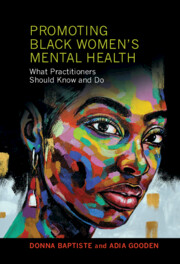Book contents
- Promoting Black Women’s Mental Health
- Promoting Black Women’s Mental Health
- Copyright page
- Contents
- Figures
- Tables
- Contributors
- Introduction
- Part I Black Women in Context
- Part II Therapy Contexts
- Part III Core Themes in Black Women’s Stress and Distress
- 8 Strong Black Woman Persona: Mental Health Impacts
- 9 Shifting in Black Women: Clinical Implications
- 10 Black Women’s Mothering and Caregiving
- 11 Black Women’s Romantic and Intimate Relationships
- 12 Appearance Prejudice and Discrimination against Black Women
- Part IV Helping Black Women Recover and Thrive
- Appendix
- Index
- References
9 - Shifting in Black Women: Clinical Implications
from Part III - Core Themes in Black Women’s Stress and Distress
Published online by Cambridge University Press: 22 June 2023
- Promoting Black Women’s Mental Health
- Promoting Black Women’s Mental Health
- Copyright page
- Contents
- Figures
- Tables
- Contributors
- Introduction
- Part I Black Women in Context
- Part II Therapy Contexts
- Part III Core Themes in Black Women’s Stress and Distress
- 8 Strong Black Woman Persona: Mental Health Impacts
- 9 Shifting in Black Women: Clinical Implications
- 10 Black Women’s Mothering and Caregiving
- 11 Black Women’s Romantic and Intimate Relationships
- 12 Appearance Prejudice and Discrimination against Black Women
- Part IV Helping Black Women Recover and Thrive
- Appendix
- Index
- References
Summary
Drawing on the work of Jones and Shorter-Gooden (2003), we review the concept of “shifting” as it relates to Black women and the contexts in which they live and move. We discuss the ways that Black women may shift in the context of their workplace, intimate, and familial relationships. We highlight how shifting can be unavoidable and automatic for Black women, which can also leave them feeling inauthentic. We share the emotional toll that shifting can take on Black women. This chapter includes specific recommendations to increase Black female clients’ awareness of shifting with strategies to help them settle into authenticity and self-acceptance.
- Type
- Chapter
- Information
- Promoting Black Women's Mental HealthWhat Practitioners Should Know and Do, pp. 214 - 235Publisher: Cambridge University PressPrint publication year: 2023



